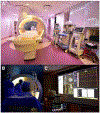MRI Catheterization: Ready for Broad Adoption
- PMID: 32198594
- PMCID: PMC7416558
- DOI: 10.1007/s00246-020-02301-6
MRI Catheterization: Ready for Broad Adoption
Abstract
In recent years, interventional cardiac magnetic resonance imaging (iCMR) has evolved from attractive theory to clinical routine at several centers. Real-time cardiac magnetic resonance imaging (CMR fluoroscopy) adds value by combining soft-tissue visualization, concurrent hemodynamic measurement, and freedom from radiation. Clinical iCMR applications are expanding because of advances in catheter devices and imaging. In the near future, iCMR promises novel procedures otherwise unsafe under standalone X-Ray guidance.
Keywords: Congenital heart disease; Interventional MRI; MR fluoroscopy; Magnetic resonance imaging (MRI).
Conflict of interest statement
Figures






References
Publication types
MeSH terms
Grants and funding
LinkOut - more resources
Full Text Sources

